Category: Tree Care
Are your trees getting enough water?
Watering tips from the Eugene Team
This July didn’t hesitate to remind us just how hot it can get in an Oregon summer, with five consecutive days with highs over 100° Fahrenheit. And while many of us are lucky to be able to find shelter from a heatwave, trees don’t have that same luxury. For young trees in particular, extreme heat can cause tremendous stress and threaten the trees’ survival.
“It’s around this time every year when we start getting a steady flow of concerns about the well-being of young trees,” says Eugene Director Erik Burke. “Trees can dry out in just a couple days in a heatwave. There are a lot of factors that go into it, including the species and the site conditions.”
Trees that are getting too much water or not enough water can show similar symptoms. Most notably, their leaves will start to brown and curl. In most instances that a tree is getting too much water, it’s because the resident has lawn irrigation systems. It’s more common that a tree is under-watered.
“It can be hard for people to apply enough water,” Erik says. “Sometimes I see people misting the ground beneath their tree with a hose and then walking away. And there wasn’t even enough water to penetrate the soil.”
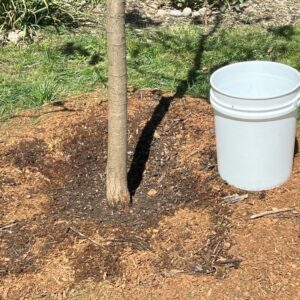
Trees need deep weekly watering during hot dry summer months: 10 to 15 gallons of water around the base of the tree. It’s important to imagine where the roots are. You want the water to be reaching through the soil to the ends of those roots. It’s also good practice to water in the morning or the evening when you’ll lose less moisture to evaporation. A thick layer of mulch will help retain moisture in the soil.
During a heatwave, your tree might need to be watered more often than once a week, but how do you know if it’s time to water? You can test the soil! There are inexpensive soil moisture readers available at hardware stores, or you can use something you have readily on hand, like a pencil or a stick.
“It’s like testing a cake to see if it’s done,” says Taylor Glass, our Eugene Springfield Program Manager. Insert your pencil several inches into the soil. When you pull it back up, if soil has stuck to the pencil then it still has moisture and you don’t need to water just yet. If it comes up dry you can go ahead and water your trees. Different soil types will dry out faster than others, so it’s important to check regularly and get to know your tree’s particular site.
“Some trees will suddenly torch, that is, get really dry and stressed,” Erik says. “As soon as you see that, you just want to water the heck out of it. Every species has a different tipping point.”
Some species like the Oregon ash or California buckeye will call it quits for the year when the soil gets dried out in August and just drop their leaves. When they come back next year they’re totally fine. But other trees won’t survive.
To help new tree owners take care of their trees, Friends of Trees sends out volunteer summer inspectors. For the first three summers of a tree’s life it will get two visits. The inspector will check on the tree’s well-being, look for any issues or concerns, and check the soil to see if there’s enough moisture.
“It’s a really fun role,” Taylor says.” You get to learn about trees while walking or biking around your neighborhood.”
With heat waves becoming more and more common, we need trees and the shade they provide to keep us cool. We need to return the favor and make sure we take care of trees so that they can survive and thrive.
Show Your Trees Some Tree-LC
Caring for trees of all ages creates the diverse urban forest we need!
Sometimes trees need a little tree love + care. When we take care of our trees, we help them take care of us. This is the beautiful relationship between trees and community that is at the core of Friends of Trees. You can help foster and expand your community of tree stewards.
Because we are a tree-planting organization, we usually focus on young tree care. As our Community Tree Care Coordinator Andrew Land puts it, “we’re really in the business of pediatric arboriculture stewardship training.” That mouthful of words aside, we focus on young trees getting the care they need so that they can survive to be mature trees.
“We often talk about how important it is to have a diversity of tree species,” Andrew says. “It’s also really important that we have a diversity of tree ages. Trees planted at the same time will theoretically time out at the same time.”
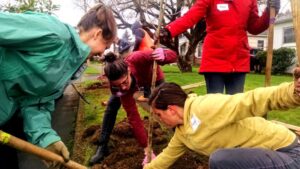
While it’s important that we plant and develop our urban forest, it’s also important that we nurture and maintain. It’s not one or the other. It has to be both.
“When we talk about the public health benefits of trees, we’re really talking about mature trees,” Andrew says. “The benefits of a tree—like its ability to clean air and water—expands exponentially each year.”
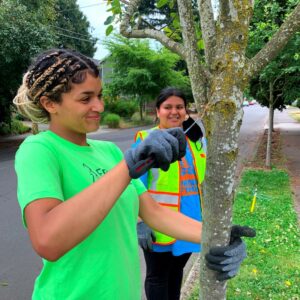
This is why we don’t just plant trees and walk away. So what are some of the things you can do to take care of your trees? We encourage you to make a tree care plan for all your trees, no matter how old. The right attention over the years can maximize the life of your tree and the benefit it provides.
For the first few establishment years, proper watering and mulching are crucially important. After that, trees are relatively low maintenance, but you should still make sure to do regular inspection and maintenance pruning every few years. Maintaining a healthy mature tree provides so many benefits to you and your whole neighborhood.
“One of the best things you can do is simply notice,” Andrew says. “Notice how the trees at your own home are doing. Notice how your neighbors trees are doing. Talk to your neighbors about their trees.”
For example, if you see a particularly special mature tree, talk to the owner about nominating it for special status and protections, like the Portland Heritage Tree Program.
Together, we can’t plant so many trees in just a single Saturday morning. Tree care can be a lifelong mission. Check out some resources here.
Let’s Talk About Tree Care
How does Friends of Trees set trees up for a long, impactful life?
Trees are one of the most cost-effective answers we have to the growing challenges of climate change. It’s a simple fact that we need more trees and native plants. But it’s not as simple as just planting them. To make sure that trees and plants survive and thrive, we need to invest in after-planting care. Watering, mulching, and regular inspection during a tree’s first three years, plus appropriate pruning in a tree’s first seven years, do wonders for setting that tree up to provide its full benefit for decades and beyond.
“In short, trees are cheap and human lives are valuable.”
-USFS Researcher Dr. Geoffrey Donovan, whose research found an association between trees planted by Friends of Trees and lower mortality (Learn more)
We’ve planted close to a million trees and native plants in the 34 year history of Friends of Trees. We know that they don’t all make it. But when we plant The Friends of Trees Way, we are working hard to ensure that trees and native plants flourish, so that they can shade our homes and streets, clean our air and water, and make our neighborhoods more liveable.
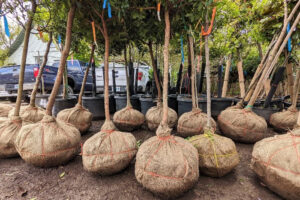
RIGHT TREE, RIGHT PLACE
Planting trees in an urban environment presents unique challenges to trees that would otherwise do well in a forest. Climate change complicates the matter even further. The success of a tree has so much to do with its specific environment—soil, space, sunlight, and moisture availability. Making thoughtful choices for each and every tree and green space planting site—and incorporating climate-adaptive species whenever possible—is a huge part of setting trees and plants up for success.
“The better we can guide folks to right tree, right place, the lower maintenance and longer lived our trees will be,” says Senior Neighborhood Trees Specialist Andrew Land. “Plant a shade-lover in full sun and you’ll either need to water it regularly to keep it looking fresh or you’ll need to replace it before long.”
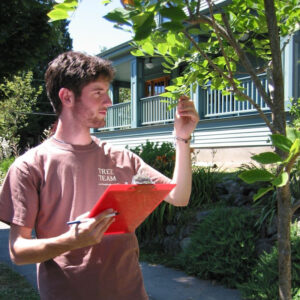
POST-PLANTING INSPECTION AND CARE
The work doesn’t stop after a tree goes into the ground. We build three years of post-planting establishment care into our tree care plans. Making sure a tree is watered and mulched during those first few years is crucial. We train volunteers to serve as summer inspectors who visit trees twice during their first summer and make recommendations to the tree recipient as needed.
We also provide tree recipients with educational materials after the planting, send mailings and reminder emails. See our tree care guide here.
Hotter and drier summers in the Willamette Valley will make tree survival increasingly challenging regardless of who planted them. This is why Friends of Trees is encouraging funders to evolve our standardized three-year tree care model to five years of watering, summer monitoring, and periodic tree pruning.
COMMUNITY ENGAGEMENT
One of the reasons that the Friends of Trees tree planting model centers on community tree education and volunteerism is because it produces an extra layer of stewardship and protection for those trees planted by community members. By working with tree recipients, volunteer planters and volunteer summer inspectors, we help tree knowledge spread throughout the neighborhoods where we work, and more and more people become invested in the health of the trees and can help identify trees in need of assistance and care for them before it’s too late.
People want to plant trees, and that’s awesome! But we need support for post-planting care, too. At Friends of Trees, we don’t just plant a tree and walk away. It’s imperative to make sure that trees get the chance to flourish, especially in places like East Portland, a low-canopy area of the city that accounts for many of the city’s heat-related deaths.
Your support will help us expand our tree care program.
When a volunteer plants a tree, it often becomes sentimental and the volunteer becomes invested in seeing the tree healthily mature over the years. This is the sort of relationship with trees that we encourage with our tree recipients and volunteers. Trees are more than a utility to be managed. They provide benefits both tangible and intangible, and they enrich our lives and communities, more and more as they grow and mature.
Leaflet: Watering
Determining Your Tree’s Watering Needs
We’ve had a wet April, which means your trees are getting plenty of water! But the transition from spring to summer can be a tricky time to determine when to water your tree. Come this time of year, we recommend watering once a week when the weekly rainfall is less than one inch. But you might find yourself wondering, “when did it rain last?” (You can check here!)
Too much watering is the most common mistake, but consistent watering is crucial to getting these young trees established. A good way to know if your tree needs water is to check the soil. Stick a garden trowel or even a pencil 2-3 inches into the soil. If the soil at that depth is dry to the touch, then your tree is ready to be watered.
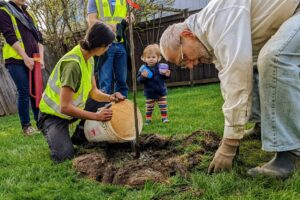
Once the dry season settles in, watering once a week is a good schedule (pick a day to water and keep it up!). Deep watering is best for these newly planted trees. Give 10-15 gallons at a time. Water slowly so that moisture soaks deeply into the soil and water doesn’t run away from the root zone. Mulching is a great way to hold water in the soil for your new trees.
“I always say that roots are infamously “lazy” and grow in response to mild stress, just like human muscle,” says Neighborhood Trees Senior Specialist Andrew Land. “We lift weights to encourage human muscle growth, whereas we water deeply and hold off for a week to encourage roots to follow that water downward, which helps establish sinker roots to fend off future drought.”
Trees and perennials have more vast root systems that hold up for the long haul, and they need deep and infrequent watering. Flowers and annuals need more daily and superficial watering, which just doesn’t work for a tree. Tree roots are growing 12-18″ down and just don’t get enough benefit from daily irrigation that is intended to water lawns.
Either a gator bag, hose on a gentle trickle for maybe 20 minutes, or a 5-gallon bucket with three 1/8″ holes drilled on the side at the bottom and filled 2-3 times consecutively works great. It’s a good practice to move the bucket around the tree each time you fill it to ensure that the whole root system gets water. Think of it this way: we’re trying to simulate a rain storm, during which all parts of the root system will get water at about the same time and rate.
It’s important to note that dry and hot are two different things. In late spring and early summer, we may get some seemingly perfect weather, and you don’t think to water your tree because it isn’t hot outside. But regardless of temperature, a dry spell is characterized as 2-3 weeks without significant rainfall. It might not be hot out, but your tree still needs a drink!
If the temperature gets over 90 degrees, bump your watering schedule up to twice a week. If we see another heat “event” coming, a good, deep soak beforehand can help the tree survive.
Leaflet: Spring Tree Care
Spring has Sprung – What that means for your trees
Spring has truly come in fits and starts this year. Some of us might still feel like it’s winter, and some are ready to announce that Spring has sprung! Trees are the same way when it comes to breaking dormancy. Some are early risers, and some sleep in. A bunch of factors go into it, including species, daylight, and temperature.
Spring is the perfect time to notice seasonal cycles. The study of these periodic events in biological life cycles is called phenology. When does a tree go dormant, when do you start to see buds, how long is the growing season? We can see quite a range among species.
“Cornelian cherries normally bloom about this time of year,” says Neighborhood Trees Senior Specialist Andrew Land. “Whereas a few years back, someone approached me about an Oregon white oak that they thought was dead, until it finally broke bud in June.”
Andrew and other staff at Friends of Trees keep an eye on phenology as it particularly relates to survival. They take note of trends in trees’ responses to different stimuli like light and temperature, with the intent to prioritize the most climate adapted species.
Here are some things you can do to take care of your trees this time of year.
Mulch Madness
It’s a great time to refresh mulch as needed. The objective is to mulch the tips of the roots as they grow outward from the base of the trunk. They will grow into soil that’s moderate in temperature and contains moisture, factors that mulch will provide. Because the roots are growing outward, when you mulch trees in their second year in the ground, aim for more of a 4-5′ diameter ring of mulch, still 3” thick, about a foot from the base of the trunk.
You may have noticed that some trees hold their leaves through winter. They’re called marcescent leaves, and they are a sign of last season’s growth. You’ll see them on native oaks like Oregon white oak (Quercus garryana) and scarlet oaks (Quercus coccinea). Come spring time’s flush, these leaves will be shed to make room for new growth. You can use these leaves as mulch!
 Go easy on the pruning
Go easy on the pruning
It’s best to go easy with regard to pruning during “bud break.” This is when sap is rising up the tree, after having dropped to the roots in the fall. As the sap is rising, some trees (maples, for example) will “bleed” if pruned as sap is rising. It’s not harmful to the tree—that’s where maple syrup comes from, after all—but it can be disconcerting to see.
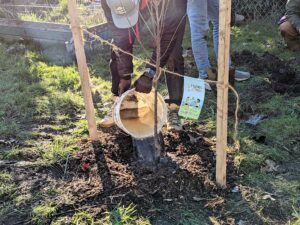
Weekly Watering
It’s almost time to start weekly watering for newly planted trees. “Deep and infrequent” is the recipe for success. Starting mid-April, 15 gallons all at once, once a week is ideal. Either a gator bag, hose on a gentle trickle for maybe 20 minutes, or a 5-gallon bucket with three 1/8″ holes drilled on the side at the bottom and filled 2-3 times consecutively works great.
If the temperature gets over 90 degrees, bump that up to twice a week. If we see another heat “event” coming, a good, deep soak beforehand is very wise as preventative medicine.

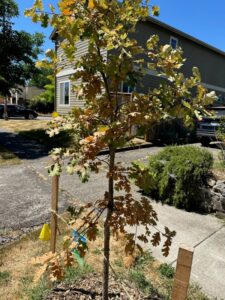


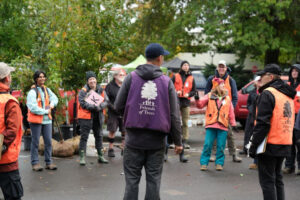

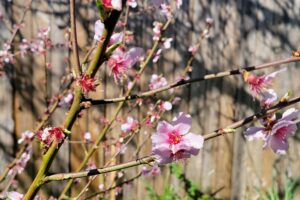
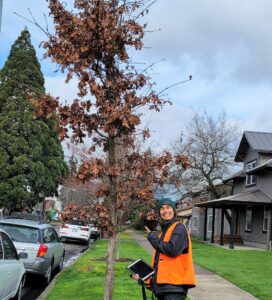 Go easy on the pruning
Go easy on the pruning